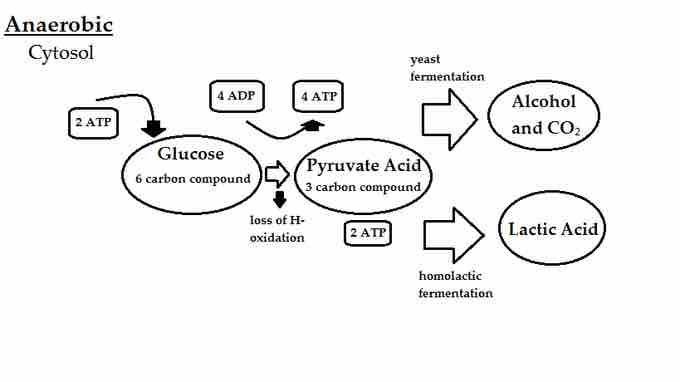Anaerobic respiration is the formation of ATP without oxygen. This method still incorporates the respiratory electron transport chain, but without using oxygen as the terminal electron acceptor . Instead, molecules such as sulfate (SO42-), nitrate (NO3-), or sulfur (S) are used as electron acceptors. These molecules have a lower reduction potential than oxygen; thus, less energy is formed per molecule of glucose in anaerobic versus aerobic conditions.

Anaerobic Respiration
A molecule other than oxygen is used as the terminal electron acceptor in anaerobic respiration.
Many different types of electron acceptors may be used for anaerobic respiration. Denitrification is the utilization of nitrate (NO3−) as the terminal electron acceptor. Nitrate, like oxygen, has a high reduction potential. This process is widespread, and used by many members of Proteobacteria. Many denitrifying bacteria can also use ferric iron (Fe3+) and different organic electron acceptors.
Sulfate reduction uses sulfate (SO2−4) as the electron acceptor, producing hydrogen sulfide (H2S) as a metabolic end product. Sulfate reduction is a relatively energetically poor process, and is used by many Gram negative bacteria found within the δ-Proteobacteria. It is also used in Gram-positive organisms related to Desulfotomaculum or the archaeon Archaeoglobus.
Sulfate reduction requires the use of electron donors, such as the carbon compounds lactate and pyruvate (organotrophic reducers), or hydrogen gas (lithotrophic reducers). Some unusual autotrophic sulfate-reducing bacteria, such as Desulfotignum phosphitoxidans, can use phosphite (HPO3-) as an electron donor. Others, such as certain Desulfovibrio species, are capable of sulfur disproportionation (splitting one compound into an electron donor and an electron acceptor) using elemental sulfur (S0), sulfite (SO3−2), and thiosulfate (S2O32-) to produce both hydrogen sulfide (H2S) and sulfate (SO2−).
Acetogenesis is a type of microbial metabolism that uses hydrogen (H2) as an electron donor and carbon dioxide (CO2) as an electron acceptor to produce acetate, the same electron donors and acceptors used in methanogenesis.
Ferric iron (Fe3+) is a widespread anaerobic terminal electron acceptor used by both autotrophic and heterotrophic organisms. Electron flow in these organisms is similar to those in electron transport, ending in oxygen or nitrate, except that in ferric iron-reducing organisms the final enzyme in this system is a ferric iron reductase. Since some ferric iron-reducing bacteria (e.g.G. metallireducens) can use toxic hydrocarbons (e.g. toluene) as a carbon source, there is significant interest in using these organisms as bioremediation agents in ferric iron contaminated aquifers.
Other inorganic electron acceptors include the reduction of Manganic ion (Mn4+) to manganous (Mn2+), Selenate (SeO42−) to selenite (SeO32−) to selenium (Se), Arsenate (AsO43−) to arsenite (AsO33-), and Uranyl (UO22+) to uranium dioxide (UO2)
Organic compounds may also be used as electron acceptors in anaerobic respiration. These include the reduction of fumarate to succinate, Trimethylamine N-oxide (TMAO) to trimethylamine (TMA), and Dimethyl sulfoxide (DMSO) to Dimethyl sulfide (DMS).